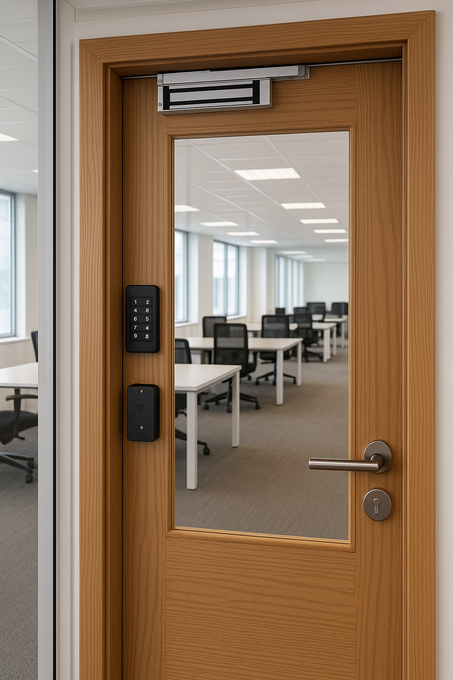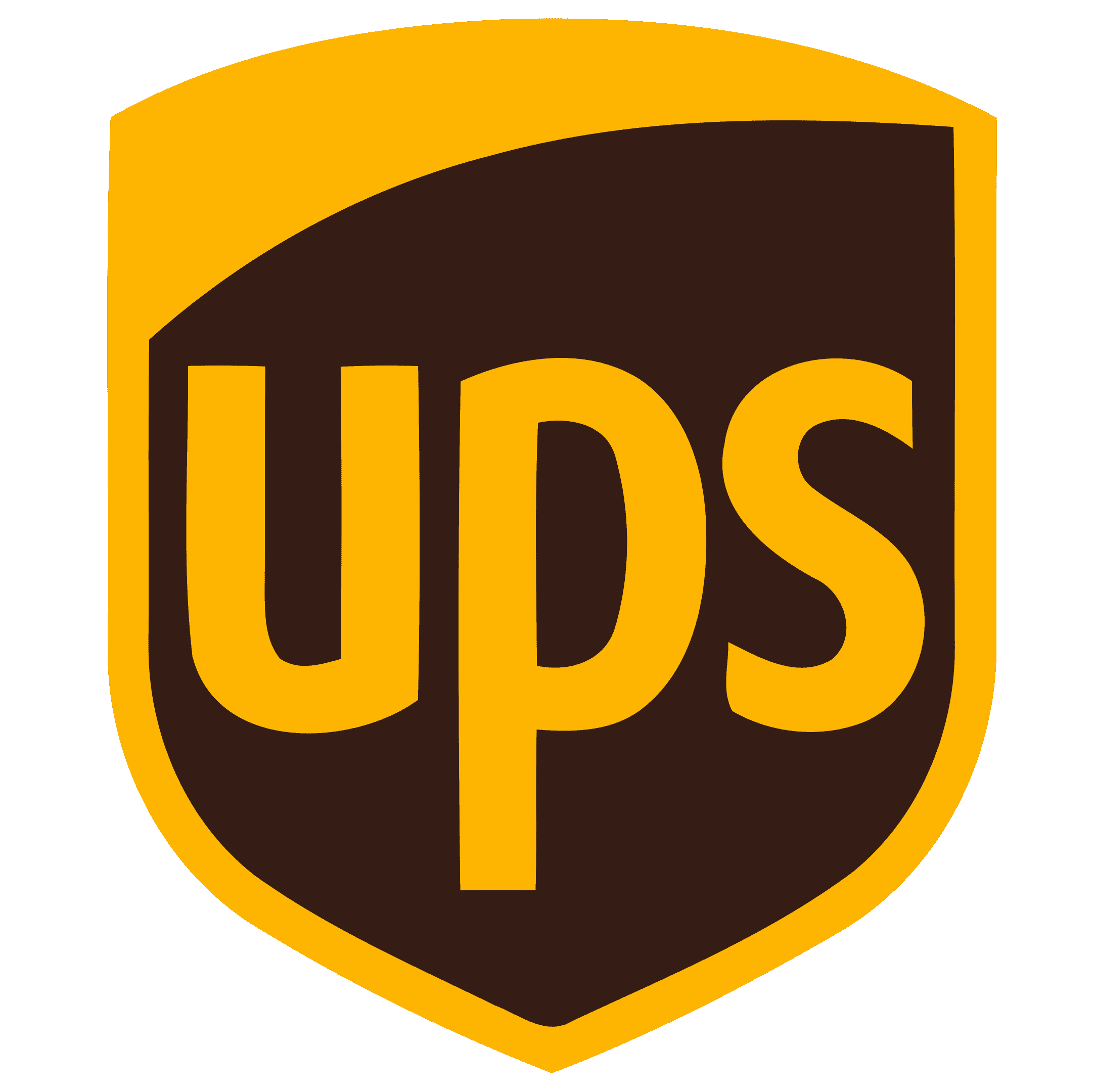
What Is Magnetic Locking and How Does It Work?
Posted by National Lock Supply on Oct 27th 2025
Magnetic locking, often called maglock technology, is one of the most reliable and widely used methods of securing commercial doors today.
Instead of using mechanical bolts or latches, a magnetic lock relies on electromagnetism to hold a door closed with tremendous force.
Simple, durable, and tamper-resistant, maglocks are a cornerstone of modern access control systems in offices, hospitals, schools, and industrial facilities. This guide explains what magnetic locking is, how it works, and where it’s used—plus when to choose it over a traditional electric strike or mechanical lock.
What Is a Magnetic Lock (Maglock)?
A magnetic lock, or maglock, is an electromagnet and armature plate system that uses an electrical current to create a strong magnetic bond between a door and its frame. When energized, the magnet and plate attract each other tightly, keeping the door securely locked. When power is cut, the magnetic field disappears, and the door opens.
Unlike mechanical locks, maglocks have no moving parts, which makes them highly durable and ideal for high-traffic, low-maintenance environments.
Core Components
- Electromagnet: Mounted on the door frame and connected to power.
- Armature Plate: Attached to the door, made of ferrous metal.
- Power Supply: Usually 12VDC or 24VDC, providing continuous power.
- Control Device: A switch, access reader, or fire alarm that controls power flow.
How Do Magnetic Locks Work?
When electric current passes through the magnet coil, it generates a magnetic field that attracts and holds the armature plate against it. This attraction can create a holding force of 600–1,200 pounds (or more)—strong enough to keep most commercial doors closed even under pressure.
To release the door, power is temporarily interrupted—by a card reader, keypad, request-to-exit sensor (REX), or fire alarm relay—allowing the magnetic field to drop and the door to open freely.
Because they depend on electricity, maglocks are classified as fail-safe devices: they unlock automatically if power is lost, which ensures safe egress during emergencies.
Where Magnetic Locks Are Used
Maglocks are common in commercial and institutional settings where controlled access is needed without complex mechanical hardware. Typical applications include:
- Glass storefront doors
- Server rooms and data centers
- Hospitals and labs
- Office entryways and corridors
- Retail stockrooms and warehouses
- Emergency exits with fire alarm release
They’re especially useful on frameless glass or aluminum doors, where installing traditional mechanical locks may not be practical.
Advantages of Magnetic Locking Systems
Magnetic locking systems offer a range of advantages that make them a popular choice for modern access control setups. Their durability stands out — with no mechanical moving parts, maglocks experience minimal wear and require very little maintenance over time. They also provide exceptionally quiet operation, making them ideal for environments such as hospitals, offices, and schools where noise reduction is important. Installation is another plus; because they’re surface-mounted, they can be fitted quickly without the complex door preparation required for traditional locks. In addition, maglocks integrate seamlessly with access control systems, easily connecting to keypads, card readers, or full building management systems.
From an aesthetic and compliance standpoint, magnetic locks blend perfectly with modern glass or aluminum doors, maintaining clean architectural lines while meeting major safety and accessibility standards such as NFPA 101 Life Safety and ADA guidelines when properly paired with request-to-exit and emergency release hardware. These features make maglocks a strong choice for commercial facilities looking for both performance and appearance.
Limitations to Consider
However, there are a few limitations to consider. Magnetic locks are power-dependent, meaning they require a constant electrical current to stay locked. Without a reliable backup supply, a simple outage can compromise door security. Because maglocks are inherently fail-safe — unlocking when power is lost — facilities may need to add extra after-hours protections, such as security patrols or secondary locking mechanisms.
Finally, compliance with local building and fire codes is critical. Most jurisdictions require maglock installations to include request-to-exit (REX) devices and integration with the fire alarm system to ensure doors unlock safely in emergencies. For exterior doors or high-security applications where maintaining lock integrity during a power failure is essential, an electric strike or electromechanical deadbolt may offer a better balance of safety and security.
Installation & Safety Compliance
Installing magnetic locks must always comply with local fire and life safety codes. In most U.S. jurisdictions, maglocks require:
- A request-to-exit (REX) sensor or manual push-to-exit button
- Integration with the fire alarm circuit to unlock during emergencies
- Free egress (no special knowledge or key required to exit)
Always use UL 294-listed power supplies and ANSI/BHMA-certified hardware. For wiring and access control integration, hire a licensed locksmith or access control technician.
Why Buy Magnetic Locks from National Lock Supply
National Lock Supply offers a wide selection of commercial-grade magnetic locks from trusted brands like RCI, SDC, Schlage, and HES, available in multiple holding strengths and configurations.
- In-Stock Guarantee: Most maglocks ship same business day.
- Bulk & Contractor Discounts: Perfect for multi-door or facility upgrades.
- Trusted Certifications: All products meet ANSI/BHMA and UL standards.
- Expert Support: U.S.-based specialists available for code compliance and compatibility guidance.
From small offices to multi-site campuses, National Lock Supply provides the hardware and expertise you need for reliable, secure access control.
FAQs
1. What is a magnetic lock used for?
A magnetic lock is used to secure commercial doors electronically using electromagnetism instead of mechanical bolts. It’s ideal for glass doors, offices, hospitals, and restricted areas.
2. How does a magnetic lock work?
When powered, the electromagnet attracts a metal armature plate, holding the door closed. When power is cut—via keypad, card reader, or alarm—the door unlocks automatically.
3. Are magnetic locks safe?
Yes. When installed with a request-to-exit sensor and fire alarm release, maglocks meet NFPA 101 Life Safety Code and ADA requirements for free egress.
4. What happens if power is lost?
Because maglocks are fail-safe, they unlock when power is lost. This ensures safety during emergencies but may require backup power for after-hours security.
5. What is the holding force of a magnetic lock?
Commercial maglocks typically provide 600 to 1,500 pounds of holding force, depending on the model and application.
6. Can magnetic locks work on glass doors?
Yes. Magnetic locks are commonly used on frameless glass or aluminum doors, mounted with special brackets for aesthetic and functional integration.
7. Do magnetic locks require maintenance?
Minimal maintenance is required—periodic cleaning of contact surfaces and checking power connections is typically enough to maintain full strength.
8. What certifications should a magnetic lock have?
Look for ANSI/BHMA A156.25 and UL 294 certifications to ensure mechanical reliability and electrical safety.
 SAME DAY & EXPEDITED SHIPPING AVAILABLE
SAME DAY & EXPEDITED SHIPPING AVAILABLE





